The Acer Swift 3 SF315-41 Review: Ryzen Meets Laptop
by Brett Howse on May 3, 2018 8:00 AM EST- Posted in
- Laptops
- Acer
- AMD
- Ryzen
- Ryzen Mobile
- Raven Ridge
Wireless
Acer has outfitted the Swift 3 with a wireless NIC we’ve never tested before, at least not with this branding. The Qualcomm QCA6174A is a 2x2:2 802.11ac network adapter with MU-MIMO support and Bluetooth 4.2 It’s also the basis of the Killer 1535, which we’ve seen in plenty of devices.
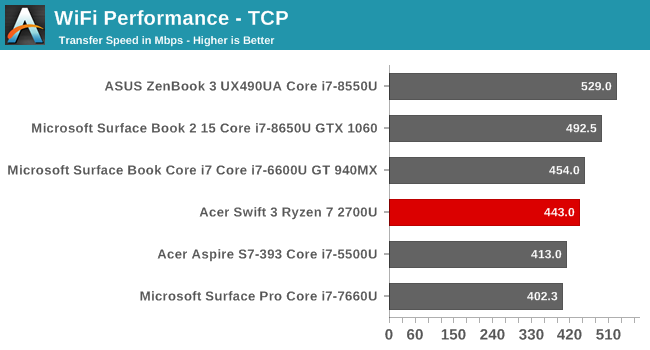
The performance in terms of bandwidth is fine for the Qualcomm NIC, but much like the Killer 1535, it suffered from several reliability issues during our testing. Several times the NIC would drop off completely, and the machine would have to be restarted to get it to see any access point again. This happened during two battery life tests, and a few other times as well, and is awfully similar to issues we saw with the Killer version of this adapter. Unfortunately we’re at a point in the PC space where there’s not a lot of choice for a quality NIC right now. We did reach out to Acer and they said they’ve not seen this issue, but this is an issue that’s plagued devices with the similar Killer 1535.
Speakers
Acer uses the Acer TureHarmony technology for their speakers in the Swift 3, and the laptop has stereo speakers, but compared to many other laptops, they have a sound that is richer than many other laptops we’ve tested, and there’s plenty of volume as well, with a maximum SPL of 84.5 dB(A) on our test track.
Thermals
With a 15-Watt TDP processor in a large 15-inch laptop, there’s going to be benefits for cooling, and that definitely plays out. The Swift 3 stays cool under all scenarios, and never gets loud.
Running the laptop under the load of Tomb Raider shows that even when gaming the system never gets excessively hot. The CPU doesn’t even get to 80°C after an extended session.
Even better, the sound level of the fan never gets excessive, with a measured SPL of just 42.3 dB(A) measured 1-inch over the trackpad. That’s very quiet when gaming.
Storage
The Swift 3 comes with just two drive options. The 2500U model features a 256 GB SSD, and the higher tier 2700U model comes with 512 GB of SSD. In the review unit, that’s the Micron 1100 SSD, which features 3D TLC with a SATA interface.
The SATA slows down the maximum performance compared to an NVMe drive, but regardless, the larger included drive in the review unit, without the normal massive price increase we see on most laptops, is very welcome.


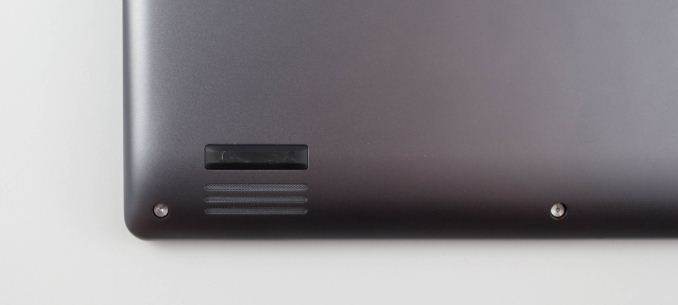
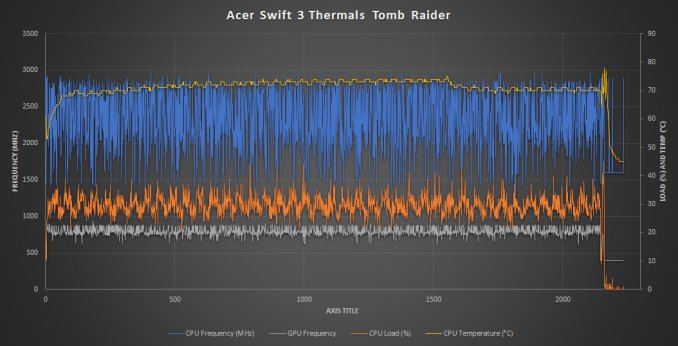
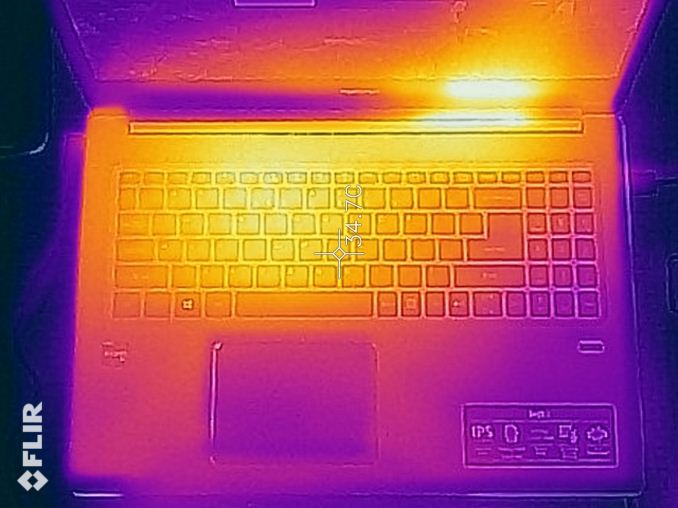
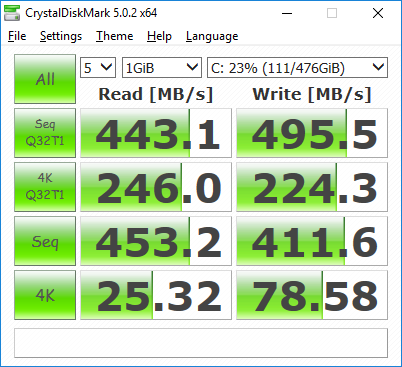








78 Comments
View All Comments
jaydee - Thursday, May 3, 2018 - link
Looking forward to Ryzen hitting the business line notebooks (Elitebook/Latitudes). Lot of employees at my company are still being given the woeful Elitebook 745 G3 (Carrizo) as of today, as band new laptops for a 4 year cycle...Jimster480 - Monday, May 28, 2018 - link
They did, and the offerings are atrocious and insanely overpriced.Valantar - Thursday, May 3, 2018 - link
This is very promising in terms of performance, even if AMD still needs to convince OEMs to build more premium SKUs with Ryzen mobile. Also, that base platform power draw needs fixing, for sure. Wonder how much of that is RAM, but I suppose that would be pretty much impossible to measure.Related to that: why doesn't RAM have some sort of turbo/power saving implementation like CPUs? Given that this likely runs dual channel 1.2V DDR4 at ~2400MT/s, couldn't the base power draw benefit massively from downclocking the RAM to, say, 1600MT/s at idle and simultaneously lowering voltage? I get that this isn't part of the DDR4 spec, and that the ICs and DIMMs as such aren't tested or certified for lower voltages and speeds, but the lack of dynamism in RAM is starting to feel old. The same goes for high-speed desktop RAM, really - why run 3600MT/s RAM idling at the desktop? It can't possibly be /that/ hard to implement a two-state (e.g. "low power" and "normal") dynamic system that's directly tied to other system loads (not just CPU, but GPU, RAM, network and disk activity too). Tuning the boost/de-clock triggers and control algorithms would likely require a bit of work, but is this really that hard to do?
I suppose this could trip up a few applications that are highly reliant on timely RAM access, but those can't be very common in normal consumer usage - and I don't envision this catching on in datcenters and the like. Might that be why we still haven't seen something like this, as businesses and server OEMs don't care?
DanNeely - Thursday, May 3, 2018 - link
If idle link throttling of DDR ever happens, I'd expect it to happen first on mobile, and then work its way up though LPDDR, to regular DDR specs. OTOH GDDR has been able to do this for a while, so it's definitely doable without seriously impacting peak performance. GPUs are power pigs, and lower idle power has been a major improvement over the last decade; but it's a segment not willing to sacrifice performance at the top to get it.You're probably right about it never making it to the data center. I've read that a number of the major cloud platforms have disabled CPU clock throttling and run at full speed 24/7 regardless of the actual load because serving responses at low speed and/or boosting back up from idle to full speed have measurable impacts on latency and the major web companies care about every millisecond there.
neblogai - Friday, May 4, 2018 - link
Gaming benchmarks show mobile Raven Ridge processors doing exactly that: RAM clock changes in the game, 933-1066-1200. You can see such behaviour in TechEpiphany's videos on youtube. However- because this is not something seen before- these readings are semi-discarded. In would be great if someone tested it properly, or asked AMD if this is how it really works, and is not an error by monitoring software.HStewart - Thursday, May 3, 2018 - link
I think for comparison, it would have been nice to test the Intel version of same model - I found it interesting that 2700 version was more expensive than the Intel with MX150. Also the Intel model was less weight which tells me Intel components are more compact. The 2700 model had more ssd but that should not be that way.Cooe - Thursday, May 3, 2018 - link
It's because of the doubled SSD size that the 2700 model is more expensive obviously.Jimster480 - Monday, May 28, 2018 - link
Its not that because the AMD machines are relegated to cheap SATA bottom of the barrel drives and ultra cheap screens. The price is just Intel making sure that nobody is going to make a competitive notebook.This laptop doesn't even land in "mainstream" it lands in "ultra budget with such a big price nobody will buy it". The screen, SSD, battery, wifi, chassis, keyboard are all unacceptable for this price range and Acer knows it aswell. But the check they receive from intel outweighs the obvious lack of sales they will have for this model.
Stuka87 - Thursday, May 3, 2018 - link
I would be surprised if you could tell the weight difference between the two. Its 4 ounces. And the Intel is cheaper because its SSD is half the size.Krysto - Thursday, May 3, 2018 - link
Still only 8GB of RAM?! Come on.